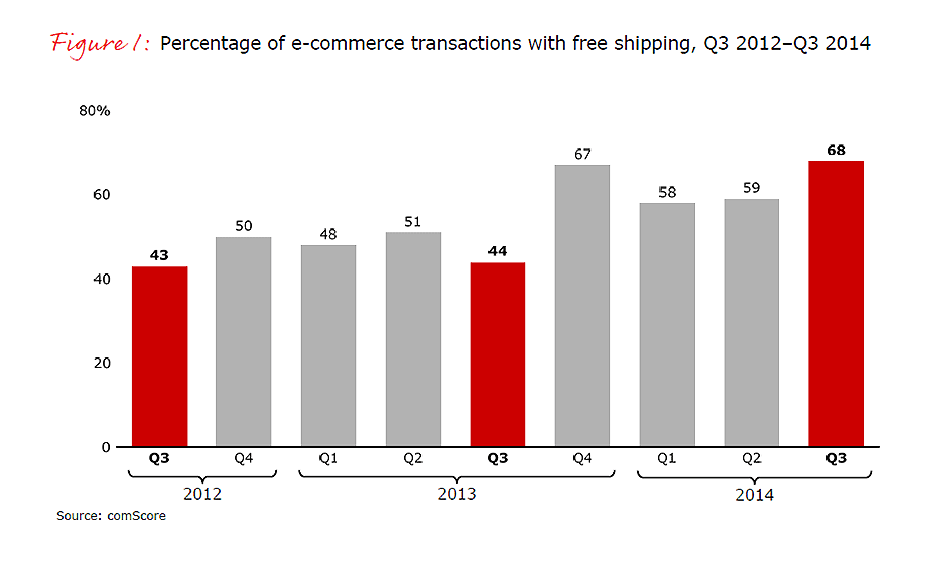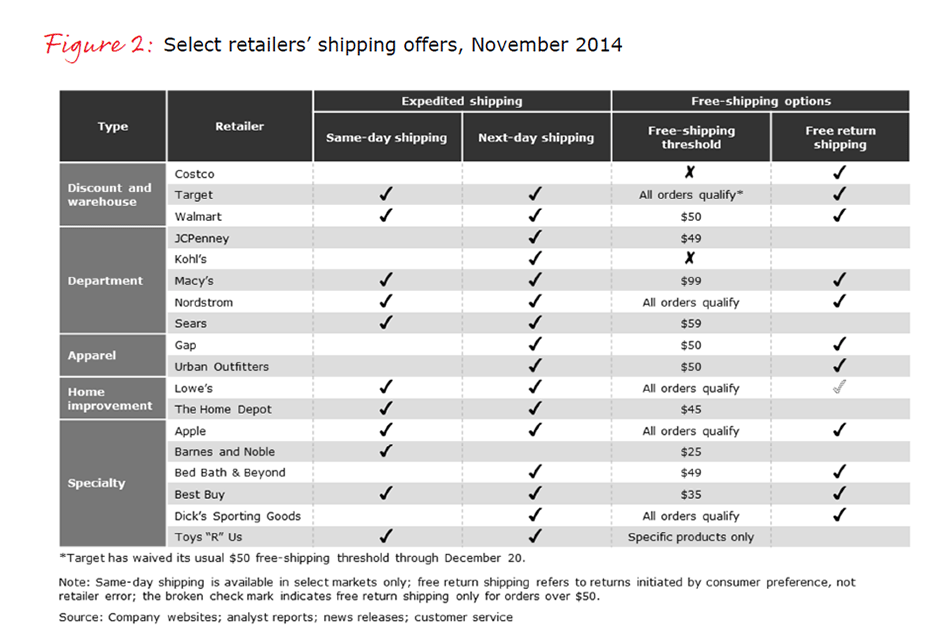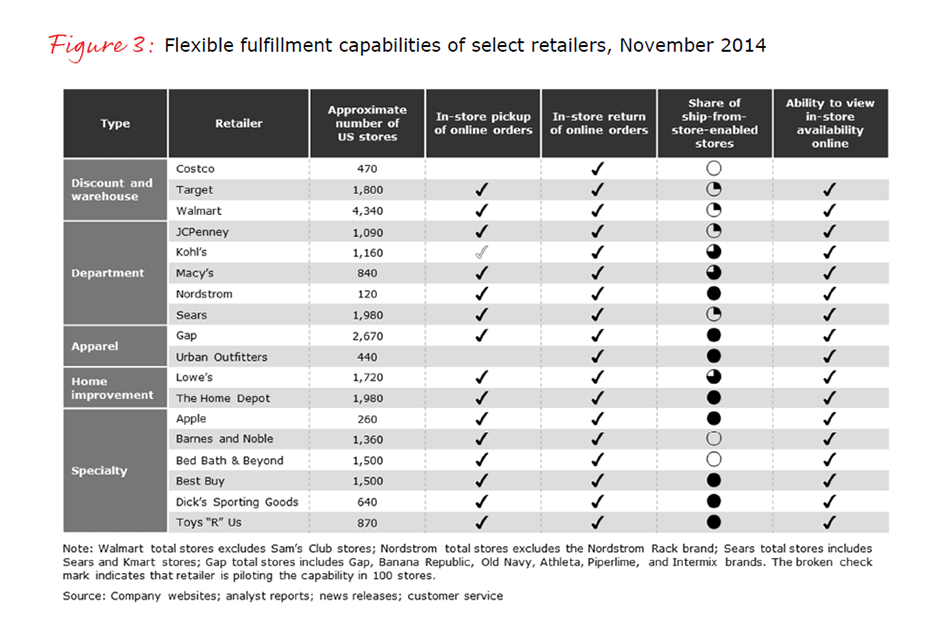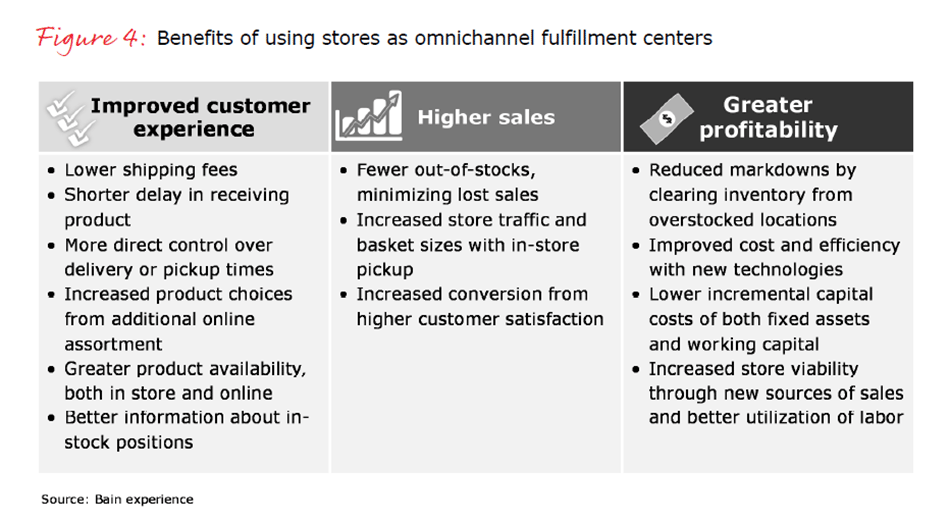Brief
Early promotions and extended hours turned Black Friday into Black November, and the busiest holiday shopping days are yet to come. Sales volumes will soon peak and supply chains will come under pressure. In this issue, we recap recent sales results, explore how customers’ expectations for order fulfillment have changed and highlight how retailers are using their stores as a competitive advantage to meet demands for fast, flexible and low-cost fulfillment.
Black Friday turned into Black November
Sales estimates for the five-day Thanksgiving weekend are surprising. The National Retail Federation (NRF) suggests sales from Thursday to Sunday were 11% lower than last year based on the self-reported spending activity of 4,600 individuals. Other sources claim sales were down 8% on Black Friday but up 19% on Thanksgiving Day. The truth is, we know very little about sales and even less about profits for the period. At any rate, sales estimates for the Thanksgiving weekend are notoriously poor predictors of how retailers will perform during the holiday season. With retailers running promotions from the first of the month, Black Friday has become Black November. The result: Consumers are spreading their spending over more days.
Online shopping continues to thrive. On Cyber Monday, the busiest online shopping day of the Thanksgiving weekend, estimates suggest that e-commerce sales increased 16% year-over-year, in line with the 16% growth seen in the third quarter. Online sales were up 20% for the five-day period and 25% on Thanksgiving Day alone. Mobile commerce was especially important on Thanksgiving Day, accounting for an estimated 50% of online browsing and more than 30% of all online spending. Amazon.com capitalized on this trend by offering holiday deals exclusively through its mobile app.
Retailers used giveaways on Black Friday to draw shoppers to their stores. Knowing that 70% of shoppers’ Black Friday spending happens in the first two stores they visit, retailers encouraged them to line up early. Target handed out savings packets filled with coupons and gift certificates when its doors opened at 6 PM on Thanksgiving; Radio Shack offered free touchscreen gloves to the first 100 customers on Black Friday; the first 100 people in line at each Old Navy store were entered to win a $1 million giveaway; and five lucky Macy’s Herald Square shoppers had their wish lists fulfilled. Best Buy, Kohl’s, Macy’s and Old Navy all opened earlier this Thanksgiving, and Kmart and Sears both stayed open for more than 30 hours straight.
Regardless of Thanksgiving sales performance, consumers have more shopping to do this holiday season. Historically, more than 55% of holiday sales have occurred in December, suggesting there’s more to look forward to. Seven of the top 10 holiday sales days of the year are still to come, with the busiest day of the season expected to be the Saturday before Christmas.
Peak volumes and retailers’ promises place strain on supply chains
Last year an estimated 2 million packages never made it to their destinations in time for Christmas. This year, UPS, FedEx and the US Postal Service are anticipating an even busier holiday season—more than 1.3 billion shipments, an 11% increase over last year. Major logistics players are preparing for the rush: They’ve hired 200,000 seasonal workers; UPS is opening 14 temporary mobile “villages” to help expedite deliveries; and the Postal Service will be delivering packages on Sundays throughout the holiday season.
UPS and FedEx are also pushing for earlier shipping deadlines, threatening to charge retailers more or even refuse packages if last-minute sales exceed volume forecasts. Despite this, more retailers are guaranteeing delivery for orders placed close to Christmas: One survey reports that 50% of retailers—up from 37% last year—plan to guarantee delivery by Christmas for orders made by December 20.
Free shipping was used for 68% of online transactions in the third quarter, up from 44% in 2013, and we expect this figure to rise even further this holiday season (see Figure 1). More than 60% of the 1,000 largest online retailers in North America are offering free shipping this holiday season. Minimum basket sizes vary, but 26% of retailers are shipping products for free whatever the order size. Target eliminated its $50 minimum until December 20, joining the ranks of Nordstrom, Apple, Dick’s Sporting Goods and others offering free shipping on all orders regardless of order size (see Figure 2).


Bain partnered with Quad Analytix1 to evaluate how retailers are featuring shipping policies and offers in promotional emails. We found that the number of promotional emails highlighting shipping since the beginning of October was 23% higher than it was during the same period last year and was 32% higher over the Thanksgiving weekend. Based on historical trends, we can expect email shipping promotions to nearly double between Thanksgiving and Christmas.
Supply chain: From back office to the front of customer experience
Shoppers are increasingly basing purchasing decisions on the speed, predictability, flexibility and cost of fulfillment. Nearly 60% of online shoppers in the United States report that shipping costs are the primary factor in determining whether to shop online with a retailer. Over 80% of consumers report that they are willing to wait up to two additional days to get free shipping, though that rate drops below 40% if the wait is four additional days. Delivery date guarantees are important to nearly all (96%) shoppers when they’re choosing among online retailers. Customers who want to avoid shipping delays or packages sitting on their doorstep for long periods increasingly opt for in-store pickup or even prescheduled same-day delivery options.
Amazon has been at the forefront of turning order fulfillment into a defining factor in customers’ experience. It has redefined shoppers’ expectations by offering a variety of shipping speeds, guaranteed delivery dates and hassle-free returns. For an annual fee of $99, Amazon provides “free” two-day shipping to its 30 million to 40 million Prime members in the United States. Members willing to delay two-day delivery get a $1 credit toward digital media purchases.
Amazon has invested heavily to provide customers with superior order fulfillment services. It subsidized $3.5 billion worth of delivery costs in 2013 and has invested $13.9 billion in building out its fulfillment centers since 2010. It has increasingly located its distribution centers near major US cities to take advantage of less costly ground transit while maintaining speed and predictability. Amazon is also reducing costs by making those facilities as efficient as possible. For example, by the end of 2014, it plans to be using nearly 10,000 Kiva robots, which triple employee productivity, up from just 1,000 in the second quarter of this year. The company has continued to expand its locker program for package pickup in major markets and began enabling returns through lockers this year. It is also continuing to innovate, experimenting with using taxis as delivery couriers and testing its own private delivery network in certain markets.
Amazon isn’t alone in driving innovation in fulfillment, particularly in densely populated urban areas:
- UPS’s My Choice program allows customers to reroute packages and choose specific delivery windows.
- ShopRunner offers its subscribers free two-day shipping and returns from a number of partner retailers.
- Google Express offers its members same-day deliveries from physical stores for a $95 a year fee.
- Retailers are partnering with Deliv and Curbside to offer same-day delivery or convenient pick-up of more goods in more locations across the country.
- Postmates, WunWun and other services offer same-day or even one-hour delivery on any purchase from any local retailer.
Stores: Tapping the power of DigicalSM to win on fulfillment
Omnichannel, or Digical, retailers—those that seamlessly integrate the best of both digital and physical worlds at each step of the customer experience—have a game-changing source of competitive advantage when it comes to fulfillment: hundreds or even thousands of stores. The proximity of stores to customers means retailers can not only get products to customers more cheaply than most online-only retailers, but also faster and within more specific delivery windows.
Stores enable “flexible fulfillment”: in-store pickups of online orders, online orders shipped directly from stores, inventory shipped between stores and in-store returns of online purchases. Many retailers have expanded their fulfillment capabilities over the course of this year. Target can now reach over 90% of the US population with its 136 recently enabled stores, and Best Buy’s 1,000-plus US stores can now ship from store (up from just 400 last year). Among others, Nordstrom, The Home Depot and Toys “R” Us have enabled almost all of their stores to handle shipping from stores (see Figure 3).

Using stores as part of a broader omnichannel distribution network substantially improves both customers’ experiences and retailers’ economics (see Figure 4). A Forrester Research study found that 88% of retailers who enabled shipping from stores saw an increase in customer satisfaction metrics. Retailers like Lowe’s and Best Buy successfully reduced average delivery times when they began shipping through their stores. Nordstrom increased product availability by shipping from stores: SKU availability went up 25% as a result of its single inventory system. Gap’s Reserve in Store program, available across about 900 US locations, lets customers check in-store product availability and reserve up to five items at no cost until closing the next day. For Walmart, same-day in-store pickup reached an all-time high on Cyber Monday, with orders up 70% over last year.
While picking and packing or processing returns in stores are more costly than doing so in an automated warehouse, higher sales, shorter shipping distances, and improved capital management make flexible fulfillment economics attractive. Better inventory management, a necessity for flexible fulfillment, leads to fewer stockouts and reduces markdowns, improving profitability. Lowe’s, for example, experienced 70% growth in online sales when it introduced shipping from stores. At Toys “R” Us, over 30% of products shipped from stores had previously been “inactive” products, which the company was able to sell at full price online instead of marking them down in stores. Customers who pick up in stores are likely to buy more merchandise once in the store, increasing both traffic and basket sizes. A recent UPS–comScore study found that of the 54% of customers who came to stores to pick up their purchases, 43% made an additional purchase.

At a time when many retailers are seeing foot traffic go down and store costs go up, using stores as mini distribution hubs can transform them from perceived liabilities into powerful assets. With higher sales from in-store pickups and shipments from stores, previously marginal stores grow more valuable. If retailers can make better use of labor in those stores, savings go up. This strategy has the potential to save stores, to preserve sales and physical presence in the marketplace, and to prevent unnecessary investment in additional distribution centers—all good things for a retailer’s bottom line.
Flexible fulfillment: A long way from business as usual
Creating a seamless flow of inventory among distribution centers, stores and customers across multiple channels requires numerous changes to a retailer’s operating model. Information systems and technology, decision-making processes, capabilities, talent and incentives all need to change. It also requires rethinking physical product flows and labor allocation in both stores and distribution centers.
If poorly executed, the benefits of flexible fulfillment can be more than offset by disappointing customer experiences and ballooning costs, impacting a retailer’s brand perception and eroding profits.
- Long wait times for store pickups have a significant impact on customer satisfaction. A study by OpinionLab found that customers’ Net Promoter Scores (NPS®) dropped drastically the longer it took to pick up online orders in the store.2 Where pickup times were less than 5 minutes, NPS was 78%; between wait times of 5 and 15 minutes, NPS was 37%; wait times longer than 15 minutes produced a greater number of detractors than promoters.
- Oversales—where products expected to be available in stores are in fact out of stock—frustrate customers. So do shelves left empty when a store’s inventory is unexpectedly used to fill a flood of online orders. When faced with a stockout, 41% of consumers go to a competitor’s website or app and 21% go to a competitor’s physical store to find the same or a similar product.
- Poor management of inventory flows and lack of visibility throughout the supply chain can leave orders unfilled and inventory from returns stranded, which ultimately means higher inventory costs and lost sales.
To avoid these pitfalls and reap the benefits of flexible fulfillment, retailers should consider the following questions:
- What customer experience and fulfillment options should we offer? Which options are “table stakes” and which are our most important sources of competitive differentiation? What will our targeted customers value most? Which options can we deliver at lower cost than our competitors?
- Are our fulfillment and assortment strategies in sync? If our online assortment is far broader than our store assortment, how will it affect in-store pickups and our ability to deliver quickly, to ship from stores without splitting shipments and to handle in-store returns of online orders? Can we use online insights to localize store assortments?
- Do our planning and allocation systems optimize inventory across our network of stores and distribution centers? Do those systems account for both online and offline demand around our stores and for all the ways that demand can be met? Do we have the ability to track stock levels and capacity constraints in real time to send the right volume of the right merchandise to each store, allowing us to ship from stores without depleting store shelves or know when to ship from a distribution center instead?
- How should we change our order fulfillment algorithms to optimize shipping? How can we minimize time, distance, split shipments, labor cost, stockouts, oversales, markdowns and customer frustration? Do our inventory and order management systems identify when it makes sense to ship from central fulfillment centers versus stores closest to a customer or stores farther away?
- How can we most effectively use our least productive stores? How do the economics of using unproductive stores for fulfilling online orders compare to the costs of closing those stores? Could this help avoid or delay further investment in fulfillment centers? Does it allow us to sustain a physical presence in markets we might not be able to otherwise justify?
- How do we adapt store operations and incentives to ensure a profitable, high-quality customer experience? What changes in staffing, technology tools, training and reward systems will enable our stores to compete with the efficiencies of large-scale fulfillment centers? How should we balance staff specialization with flexibility at peak times? How could store layouts make in-store pickups more convenient and productive?
- What capability and talent gaps do we have? Where do we need to build new capabilities? Where can we train our existing workforce? How do we align corporate incentives to cut across channel focus?
- How could investments in radio frequency identification (RFID), advanced analytics, micro robotics or other new technologies create new sources of competitive advantage?
- Could we sell a fulfillment center or two? Have our store capabilities created so much high-quality capacity that we might sell traditional fulfillment centers and invest the proceeds in more innovative store technologies?
What’s next for flexible fulfillment?
Steve Jobs once declared, “Innovation distinguishes between a leader and a follower.” In retail, leaders continue to redefine fulfillment capabilities. It is one thing to ship 100 packages a day from a number of stores; it is quite another to ship thousands of packages from nearly all stores or to replace conventional fulfillment methods with leapfrog technologies.
Technology is making traditional capabilities obsolete. Micro robotics may soon enable the automation of stores’ back rooms. Amazon Prime Air is looking to use drones to deliver orders weighing up to 5 pounds within 10 miles of fulfillment centers in less than 30 minutes. Google’s Project Wing is exploring drones to deliver products across cities within a minute or two. (A recent ruling by the Federal Aviation Administration, however, has made it less likely that drones will be allowed for commercial purposes in the near future.) In the meantime, Google is also working on driverless cars and robots. And developments in 3D printing may mean that fulfillment happens in customers’ own homes. Regardless of what the future holds, retailers will need to invest in new capabilities and technologies to keep up with consumer expectations for cheaper, faster and more reliable fulfillment.
Looking forward: Future release dates and topics
In our next issue, we explore how retailers dynamically manage their pricing strategies over the holidays to contend in a highly price-competitive environment.
- Issue #4 (mid-December): The art and science of pricing
- Issue #5 (late January): Post-holiday outlook
Please let us know if you have any questions or would like to arrange a follow-up discussion on flexible fulfillment. We look forward to continuing to share news of innovations and interesting strategies with you this holiday season.
For a list of selected references, please view the full PDF.
1 Quad Analytix provides retailers with market intelligence to inform their business decisions. According to the company, it captures and analyzes product, pricing, placement and promotion data from hundreds of retailers and presents the information in an easy-to-use software-as-a-service (SaaS) application. For this newsletter, Quad Analytix tracked promotional emails from over 70 retailers across a range of sectors.
2 The Net Promoter SystemSM begins with scores from customer surveys: On a scale of 0 to 10, how likely would you be to recommend this company (or this product) to friends and colleagues? Ratings of 9 or 10 indicate promoters; 7 and 8, passives; and 0 through 6, detractors. The Net Promoter Score is simply the percentage of promoters minus the percentage of detractors.



